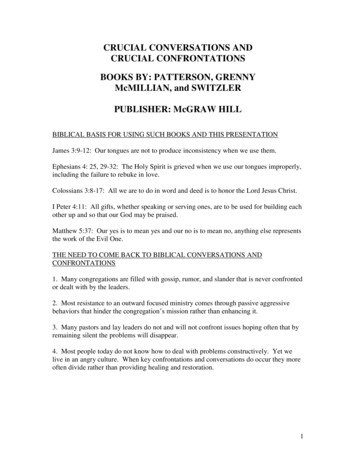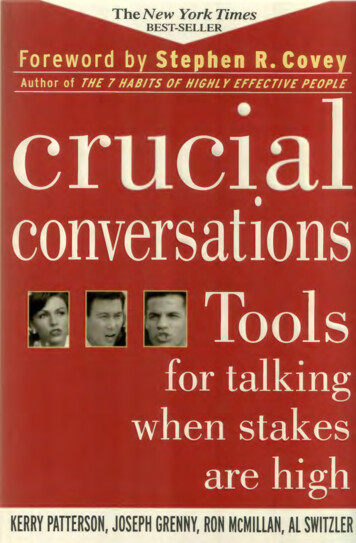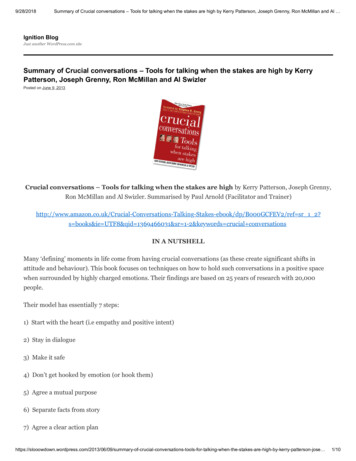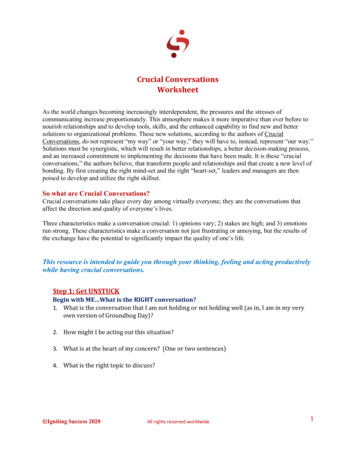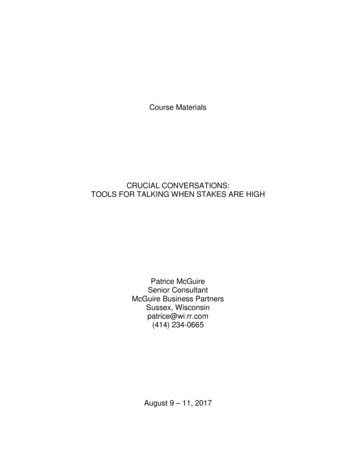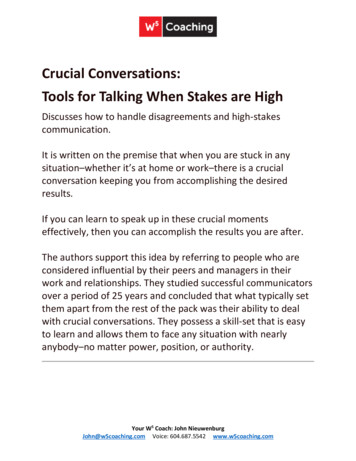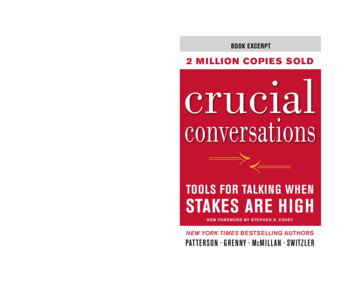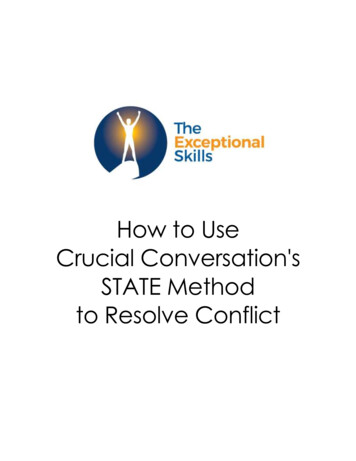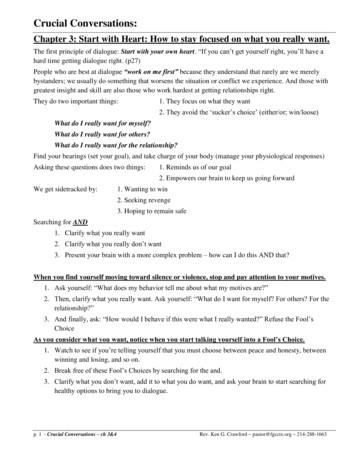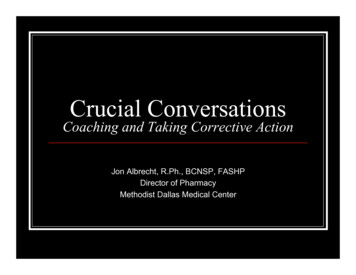
Transcription
Crucial ConversationsCoaching and Taking Corrective ActionJon Albrecht, R.Ph., BCNSP, FASHPDirector of PharmacyMethodist Dallas Medical Center
Speaker DisclosureJon Albrecht has no financial or other conflictof interest to disclose.Tony Dasher has no financial or other conflictof interest to disclose.
Educational Objectivesn n n Identify the characteristics of High, Middle,and Low performersOutline the Crucial Conversationsmethodology for sharing tough or difficultmessagesOutline the steps of a corrective actionsession
The Continuum of Correctionn n n n MentoringCoachingManagingDisciplining
Benefits of an Effective Coaching &Corrective Action Programn It’s fair---communicates to others that you are consistent and you holdeveryone accountable.n It leads to breakthroughs in team performance.n It allows the preceptor and student to “plan for improvement.”n It creates a basis for future action, if warranted.n Students know and understand what is expected.n It takes the “personality conflicts” out of the process.n It assumes students are willing and able to change their behavior.n Communicates to student: “I want to help.”n You want and need each team member to succeed.
Why is it so difficult to correctstudents? We want to be “liked,” and we may view “discipline” as an unpleasant task with negativeconnotations We may be more concerned with being liked than being respected We want to avoid the “hassles” of counseling and discipline We believe it reflects poorly on us if we admit to having to deal with performance/conductproblems We may lack the knowledge of proper procedures, or we’re uncomfortable withorganization policies We have observed other preceptors “letting things slide” We do not want to be responsible for “messing up” a student’s career We may not see the benefits of a fairly enforced correction program Some of the students we must address are friends, children of friends, future employees We lack documentation/specifics to effectively correct We are afraid of being accused of prejudice if student is a female, minority, or in aprotected class “Halo effect”: employee does some things very well, so (s)he doesn’t really need to beaddressed
What is “Coaching”n A supportive/developmental approachprimarily used with medium and highperformers
What is “Corrective Action?”n A management tool for low performers thatuses increasing degrees of firmness to helpcorrect and change behavior.n Sets stage for “therapeutic extraction” ifnecessary.
High, Middle, Low PerformersHighMiddleLowDefinitionComes to work on timeGood attitudeProblem solvesYou relax when youknow they arescheduledGood influenceUse for peer interviewsFive pillar ownershipBrings solutionsGood attendanceLoyal most of the timeInfluenced by high andlow performersWant to do a good jobCould just need moreexperienceHelps manager beaware of problemsPoints out problems ina negative wayPositions leadershippoorlyMaster of We/TheyPassive aggressiveThinks they will outlastthe leaderSays manager is theproblemResultsExceeds goalsAchieves goalsDoes not achieve goalsProfessionalismAdheres to unit policiesconcerning breaks,personal phone calls,leaving the work area,and other absencesfrom workUsually adheres to unitpolicies concerningbreaks, personal phonecalls, leaving the workarea, and otherabsences from work.Does not communicateeffectively aboutabsences from workareas. Handlespersonal phone calls ina manner thatinterferes with work.Breaks last longer thanallowed.The Studer Group
TeamworkDemonstrates highcommitment to makingthings better for thework unit andorganization as awhole.Committed toimproving performanceof the work unit andorganization. Mayrequire coaching tofully executeDemonstrates littlecommitment to thework unit and theorganization.Knowledge &CompetenceEager to change for thegood of theorganization. Strivesfor continuousprofessionaldevelopment.Invested in ownprofessionaldevelopment. Mayrequire some coachingto fully execute.Shows little interest inimproving ownperformance or theperformance of theorganization. Developsprofessional skills onlywhen asked.CommunicationComes to work with apositive attitude.Usually comes to workwith a positive attitude.Occasionally getscaught up in thenegative attitude ofothers.Comes to work with anegative attitude. Hasa negative influence onthe work environment.Safety AwarenessDemonstrates thebehaviors of safetyawareness in allaspects of work.Demonstrates thebehaviors of safetyawareness in allaspects of work.Performs work withlittle regard to thebehaviors of safetyawareness.The Studer Group
High, Middle and Low PerformersHRe-recruit and retainMSupport and coach fordevelopmentLMove up or out
The Studer Group Found .n 34% of people will improve and sustainhigh performancen 58% will do so if their behavior is properlyreinforcedn 8% will flat out refuse to budge
So What, Now What .n We need to spend 92% of our time with the92% of employees who want to be onboardn No more than 8% of our time with the 8%who do not want to be on board
Crucial Conversation ScenarioYou are meeting with a group of people, thestudent says something which contradictssomething you just said.You tell the student, “what you said was notappropriate” .
Crucial Conversations occur whenthere are .n n n Strong emotionsOpposing opinionsHigh stakes .Potentially resulting in silence or violence
Crucial Conversations Methodologyn Start with Heartn Whatdo you really want for yourself?n What do you really want for others?n What do you really what for the relationship?How would you behave if you really wanted theseresults?
Crucial Conversations Methodologyn Learn to Lookn Contentn n and ConditionsFor when things become crucialFor safety problems§ Silence (masking, avoiding, withdrawing)§ Violence (controlling, labeling, attacking)n For your Style Under Stress
Crucial Conversations Methodologyn Make It Safen Which condition of safety is at risk?n n n n n Mutual PurposeMutual RespectApologize When AppropriateContrast to Fix MisunderstandingCRIB to Get to Mutual Purposen n n n Commit to seek Mutual PurposeRecognize the purpose behind the strategyInvent a Mutual PurposeBrainstorm new strategies
Crucial Conversations Methodologyn Master My Storiesn Retrace Your Path to Actionn n n n n Act – notice your behaviorFeel – get in touch with your feelingsTell Story – analyze your storiesSee/Hear – get back to the factsTell the Rest of the Story
Crucial Conversations Methodologyn STATE My Pathn n n n n Share your factsTell your storyAsk for others’ pathsTalk tentativelyEncourage testing
Crucial Conversations Methodologyn Explore Others’ Pathsn n n n n Ask – express interest in others’ viewsMirror – acknowledge others’ emotionsParaphrase – restate what you’ve heardPrime – encourage others to contributeAs others share . Agree, Build, Compare
Crucial Conversations Methodologyn Move to Actionn n n n n n n CommandConsultVoteConsensusWho does What by WhenFollow upHold Accountable
Coaching the High Performern “Re-recruiting”n Tell them where we are goingn Thank them specifically for their superb workn Specifically outline why they are so importantn Ask if there is anything you can do for themSource: Studer Group
Coaching the Middle Performern Describe good qualitiesn Cover developmental opportunitiesn Reaffirm good qualitiesn Specifically ask for improvementSource: Studer Group
Deal with Low Performersn Not coaching-------CORRECTIVE ACTIONis needed
Prepare for the Low Performer Meetingn Clarify what exactly has the employee done wrongn Keep open mindn Review previous recordn Gather any pertinent evidence/factsn Determine if you need another preceptor or regional staff tosit inn Determine time and place—set the stage
Conducting the Low PerformerSessionn DO NOT start meeting on positive noten Goal of the meeting: very directly show student their faultn Push for them to recognize/verbalize the problemn Be direct & honest in a supportive & respectful mannern Express your disappointmentn Deal directly with defensiveness, denial, externalization of blame, & excusemakingn Be critical of the conduct, not the person (preserve/promote self-esteem)
What to Expect from the LowPerformern Excusesn Blaming othersn Pointing finger at the leadern Unloading with some personal problem withmanipulative aim of playing on your sympathiesSource: Studer Group
Dealing with Excusesn First, when given a valid reason (rare):n Acknowledge the special circumstancesn Ask for a plan to deal with similar incidents infuturen Inform student that this is a “re-training” session
Dealing with Excuses, Cont.n When given excuse intended to externalizeblame (most of the time):Focus on the “yes” or “no” before the but.”Example:n n n n Preceptor: “are you meeting the standard for being preparedfor patient care rounds?”Low Performer: “no, but, Dr. Smith never asks me anyquestions.”Preceptor: “Thank you for acknowledging that you did notmeet the standard, how can you make sure this does nothappen again?”
Use Force-Choice Questioningn Would the pharmacy be more successful if you (inappropriate behavior) or (appropriatebehavior)?n Would you be meeting your responsibility better if you or ?n Do the Standards of Performance indicate you should or ?n In the future will you or ?n Which will assure that you have a more favorable performance appraisal or?n Will it project a more positive image with your team if you or?n Should I document that you will follow the (policy, procedure, standard, etc.) or break it?
Conducting the Low Performer SessionCont.n Step 1:Ask the student in his or her own words what happened.n Step 2: Ask the student to state what should have happened (requiredperformance/behavior)n Step 3: Ask student to state if he/she is meeting their responsibility (actual vs.required performance/behavior)n Step 4: Ask the student to talk through a proposed plan for improvement (subject tothe preceptor’s approval/modification)n Step 5: Summarize the student’s comments elicited in steps 1 through 3, & theplan for improvement.n Close the meeting by stating that you will review the discussion with UT personnel.
Follow-Upn Follow up and inspect to see if theimprovement plan is being followedn Determine if there have been furtheroccurrences of inappropriate behaviorn Immediately address any further instancesof low performance
Role Play Exercises
Coaching the Middle Performern Describe good qualitiesn Cover developmental opportunitiesn Reaffirm good qualitiesn Specifically ask for improvementSource: Studer Group
Crucial Conversations Methodology ! Learn to Look ! Content and Conditions ! For when things become crucial ! For safety problems " Silence (masking, avoiding, withdrawing) " Violence (contro
